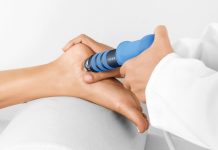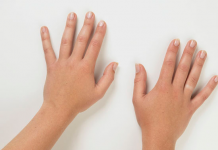PRP (PLATELET RICH PLASMA) IMPLEMENTATIONS IN THE SHOULDER JOINT PROBLEMS
Except for obvious trauma (fracture-dislocation etc.) the problems accompanied by the shoulder joint pain can be divided into some main groups:
1- Instability: The conditions like instability or laxation/not feeling safe can be collected under this group. The shoulder joint can be frequently dislocated or the person can feel like it is dislocated with some movements. This condition can start after the trauma, once it is dislocated or upon the existing infrastructure of the shoulder joint (figure 1). There is no effect of PRP implementation in this group. The patients having this problem can be subdivided into two groups after the history and physical examination. In summary, while the surgical treatment methods are highly successful in one group (TUBS), physical therapy and rehabilitation methods are more appropriate in the other group (AMBRI).
Figure 1. Recurrent shoulder dislocation after the trauma.
The Archive of Hakan Gündeş
2- Attricion: The main problem in this group which can be called as abrasion, corrosion or compression is the abrasion of some structures around the shoulder joint on the tendons enabling the movements of the shoulder (figure 2). This problem can be structural. In other words, the acromion protecting the shoulder joint may be congenitally tending to compress the tendons differently from the other people (type 3). In time, the changes occuring due to usage may cause to these problems. Such problems are generally called as impingement. The bursa called tissue which is protecting the tendons on the shoulder joint like the air cushions in the cars can get thickhened by swelling and make pressure to the tendons (stage 1 impingement). In the next stage, the thickened bursa tissue and osteofit start to abrade the tendons in addition to compression (stage 2 impingement). These tendons are the ones turning and lifting the shoulder and called as rotatorcuff. Molecular level structural changes and less quality of the tendons upon such micro-traumas is generally called as tendinitis. In the next stage, lacerations can be seen on the worn tendons with less quality. This is called rotator cuff laceration. Since the most commonly seen tendon with laceration is supraspinatus, it can also be seen as supraspinatustendinitis in some sources.
In the early stages of the disease differently called as bursitis, inpingement or supraspinatustendinitis (stage 1 and 2), generally rehabilitation and/or some medication (cortisone etc). is preferred as treatment methods. At this stage, lime can be accumulated within the tendon. This is called calcific tendinitis (video, operating theater). There is a new study dated 2012 stating that PRP use has responded positively in this disease which is generally surgically treated. Anyway, one should be careful regarding the use of PRP in the treatment of this disease.
Figure 2. Acromion and rotator cuff relation.
The Archive of Hakan Gündeş
In the next stage (rotator cuff laceration) the main treatment is suturing the laceration in its place with surgical method. The most significant complication after the surgical treatment is to have laceration again. There are a lot of issues suggesting that PRP use can strenghten the surgical repair in order to prevent this complication. While some of the studies published in many reputable magazines have stated that PRP implementation has responded positively, the other part has declared no change. Anyway, one should be careful regarding the use of PRP in the treatment of this disease.
3- Limitation of movement: The third main pathology observed in the shoulder joint is the limitation of movement. The body may develop a defense mechanism against the pain occuring due to the aforementioned problems and limit the movements of the joint. In some cases, the movements can be limited idiopathically. Basically, the wall (capsule and synovia) surrounding the joint is contracted and shrinked. This is called as frozen shoulder. The treatment methods for this are rehabilitation, manipulating under anesthesia or surgery. There is no reference regarding the PRP implementation.
REFERENCES
Platelet-richplasmaforcalcifictendinitis of theshoulder: a casereport
Barcelona, SpainJournal of OrthopaedicSurgery 2012;20(1):126-30
Exogenousapplication of platelet-leukocyte gel duringopensubacromialdecompressioncontributestoimprovedpatientoutcome. A prospectiverandomizeddouble-blindstudy. EurSurgRes. 2008;40(2):203-10.
Theeffect of platelet-rich fibrin matrix on rotatorcufftendonhealing: a prospective, randomizedclinicalstudy. Am J Sports Med. 2012 Jun;40(6):1234-41.
Plateletrichplasma in arthroscopicrotatorcuffrepair: a prospective RCT study, 2-year follow-up. J ShoulderElbowSurg. 2011 Jun;20(4):518-28.
Doesplatelet-richplasmaacceleraterecoveryafterrotatorcuffrepair? A prospectivecohortstudy. Am J Sports Med. 2011 Oct;39(10):2082-90.
Rotatorcuffrepairhealinginfluencedbyplatelet-richplasmaconstructaugmentation. Arthroscopy. 2011 Aug;27(8):1029-35.
The Role of Platelet-RichPlasma in ArthroscopicRotatorCuffRepair: A SystematicReviewWithQuantitativeSynthesis. Arthroscopy. 2012 Jun 11. [Epubahead of print].












